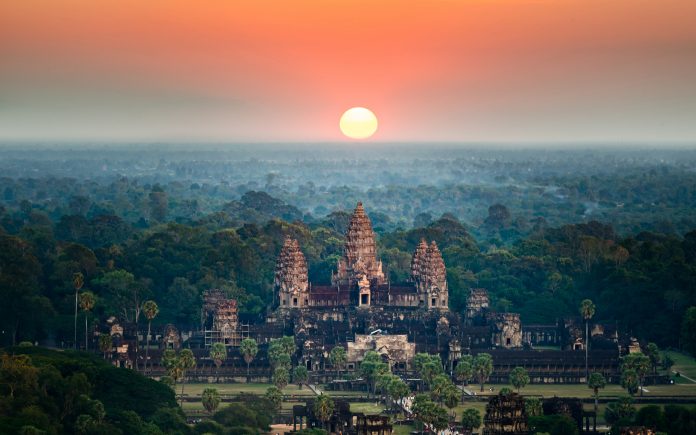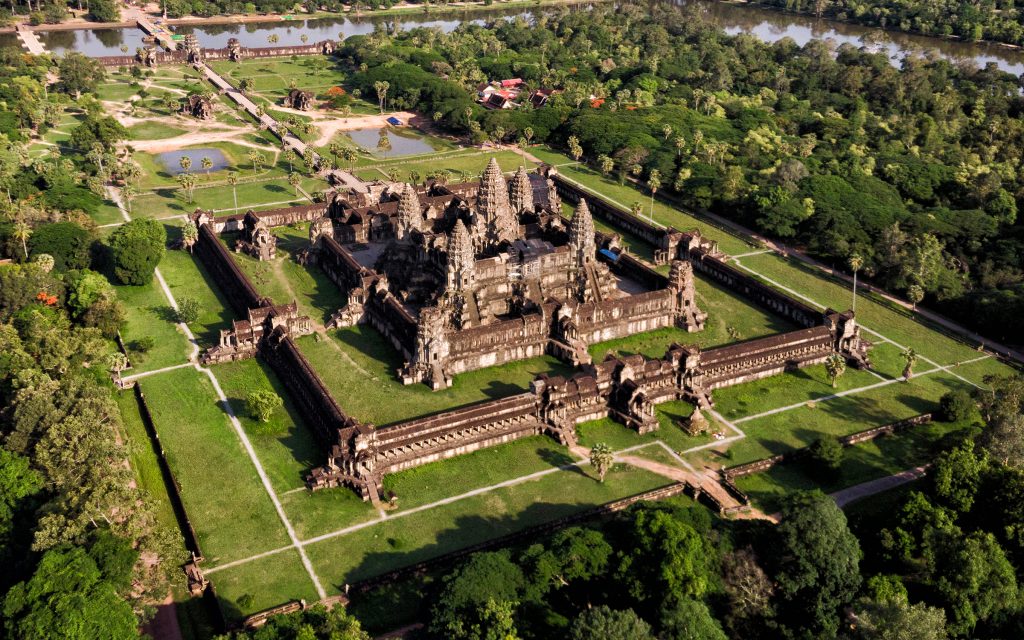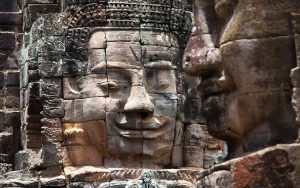
I had scoured travel magazines and websites for information about Angkor Wat, but I was still unprepared for the sheer size and magnificence of this holy site.
We arrived in Siem Riep, Cambodia via a flight from Luang Prabang, Laos on our whirlwind tour of IndoChina. And today, we were going to see the reason we had chosen this tour…Angkor Wat. (Wat means “temple.) Our tour group’s bus left the Angkor Century Resort and Spa early in the morning to beat the heat at the temple complex. (The heat can become oppressing midday.)
 My belief that the Angkor Archaeological Park simply contained one Hindu temple was incorrect. The park contains 72 large Hindu and/or Buddhist temples and stretches over an area much larger than Manhattan. The change from Hindu to Buddhist temples came about after a major battle loss to a neighboring tribe which seemed to say to the rulers that the Hindu gods had failed them, and they needed to change to a different religion. Thankfully, the Buddhist religion does not require destroying remnants of other religions.
My belief that the Angkor Archaeological Park simply contained one Hindu temple was incorrect. The park contains 72 large Hindu and/or Buddhist temples and stretches over an area much larger than Manhattan. The change from Hindu to Buddhist temples came about after a major battle loss to a neighboring tribe which seemed to say to the rulers that the Hindu gods had failed them, and they needed to change to a different religion. Thankfully, the Buddhist religion does not require destroying remnants of other religions.
Perhaps the most famous temple in the park is the iconic Angkor Wat complex. The Angkor Wat complex is the world’s largest religious structure, stretching over 400 acres. The Angkor Wat temple was begun in the 12th century by King Suryavarman II as a vast funerary temple for himself but he died before it was completed. The temple, dedicated to the Hindu god Vishnu, is built of sandstone which, unfortunately, has weathered over the thousand years.
 The temple’s magnificence is still obvious even amidst the ruins. The attention to detail with the intricate sculptures of gods is amazing. The entire temple tells stories through pictures and symbolism. For example, the five temple spires represent the five peaks of Mount Meru which for Hindu, is the center of all reality. Much like stained glass windows in medieval churches, the statues and carvings tell religious and cultural stories for the majority of people who could not read in the 12th century. Because the temple is still a working place of worship, orange-robed monks scurry to fulfill their duties.
The temple’s magnificence is still obvious even amidst the ruins. The attention to detail with the intricate sculptures of gods is amazing. The entire temple tells stories through pictures and symbolism. For example, the five temple spires represent the five peaks of Mount Meru which for Hindu, is the center of all reality. Much like stained glass windows in medieval churches, the statues and carvings tell religious and cultural stories for the majority of people who could not read in the 12th century. Because the temple is still a working place of worship, orange-robed monks scurry to fulfill their duties.
Our next stops were other famous temples…if you have ever seen the movie, Laura Croft: Tomb Raider. Bayon Temple in Angkor Thom is the multi-faced site with each of its 54 towers displaying four smiling faces of Avalokiteshvara from the Buddhist religion. We took time to climb one of the towers to gain a glimpse of the vast expanse before we moved on to the tree-entwined temple of Ta Prohm.
 Ta Prohm, like the majority of the temples, was built without the use of mortar which allowed strangler fig trees to take root and flourish during the years when it was cut off from civilization. The gigantic fig trees toppled walls and destroyed bas-reliefs before their advance was halted by archaeologists. Visitors can wander through the temple and discover glimpses into its former majesty. (I also pictured myself doing some Laura Croft moves, but I kept those to myself!)
Ta Prohm, like the majority of the temples, was built without the use of mortar which allowed strangler fig trees to take root and flourish during the years when it was cut off from civilization. The gigantic fig trees toppled walls and destroyed bas-reliefs before their advance was halted by archaeologists. Visitors can wander through the temple and discover glimpses into its former majesty. (I also pictured myself doing some Laura Croft moves, but I kept those to myself!)
 We visited multiple other temples while we were in the area, but still saw only a small portion of the park. I would love to visit again and see more of the temples and learn more of the culture and religion. A few important notes: Many people still live within the large complex and use the temples as places of worship. Visitors need to dress respectfully, cover knees and shoulders, and avoid loud talking and rambunctious behavior. Also, tourist should wear sunscreen and take water. But is it worth it? Of course!
We visited multiple other temples while we were in the area, but still saw only a small portion of the park. I would love to visit again and see more of the temples and learn more of the culture and religion. A few important notes: Many people still live within the large complex and use the temples as places of worship. Visitors need to dress respectfully, cover knees and shoulders, and avoid loud talking and rambunctious behavior. Also, tourist should wear sunscreen and take water. But is it worth it? Of course!
– Candace Ahlfinger has loved traveling since she was little and has always been on the go whenever possible. Now she is retired and gets to do what she loves best… TRAVEL! Whether it’s traveling with her wonderful husband, or our children and grandchildren, traveling is a great experience that enriches her life. Because she always enjoys reading and hearing about others’ travel experiences, she wants to share her travels with the Ellis DownHome readers.






